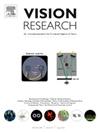Ocular vergences measurement in virtual reality: A pilot study
IF 1.4
4区 心理学
Q4 NEUROSCIENCES
引用次数: 0
Abstract
In this study, we investigated the value of using virtual reality to evaluate ocular vergence performance. We used a virtual reality device with an integrated eye-tracking system to create virtual environments that simulated far and near vision conditions and assessed ocular movements. We compared the maximum angular deviation compensated by the visual system or the vergence scores of the participants in the virtual environments with the vergence scores obtained with a prism in real environment, i.e. with the technique usually used for clinical assessments. We also compared a simple virtual environment with a complex virtual environment by creating landscapes. The vergence scores obtained for divergence and convergence with the virtual reality device were very similar to those obtained using prisms. This suggests that the virtual environments efficiently stimulated vision conditions in 3 dimensions. Our results also support the idea that modulating the angular deviation of the projected image in the virtual reality headset is a satisfactory way of inducing ocular vergences. The amplitudes of fusion were better in the virtual conditions, suggesting that the controlled virtual environments provided better conditions for measuring vergence movements. Furthermore, the virtual reality device induced a better amplitude of fusion in participants with high convergence abilities by preventing the underestimation of divergence abilities in these participants. This last result suggests that this type of virtual reality mechanism could be helpful in the future for remediating vergences-related disorders.
虚拟现实中的眼辐角测量:一项初步研究
在这项研究中,我们探讨了使用虚拟现实来评估眼聚光性能的价值。我们使用了一个集成了眼球追踪系统的虚拟现实设备来创建虚拟环境,模拟远近视觉条件并评估眼球运动。我们比较了视觉系统补偿的最大角度偏差或参与者在虚拟环境中的聚光评分与在真实环境中使用棱镜获得的聚光评分,即与通常用于临床评估的技术。我们还通过创建景观来比较简单的虚拟环境和复杂的虚拟环境。用虚拟现实装置得到的发散和收敛的聚光分数与用棱镜得到的聚光分数非常相似。这表明虚拟环境有效地刺激了三维视觉条件。我们的研究结果也支持这样一种观点,即调制虚拟现实头戴式耳机中投影图像的角度偏差是一种令人满意的诱导眼辐的方法。虚拟条件下的融合幅值较好,说明受控的虚拟环境为测量辐合运动提供了较好的条件。此外,虚拟现实设备通过防止对高收敛能力参与者的发散能力的低估,诱导了更好的融合幅度。最后的结果表明,这种类型的虚拟现实机制在未来可能有助于治疗与边缘相关的疾病。
本文章由计算机程序翻译,如有差异,请以英文原文为准。
求助全文
约1分钟内获得全文
求助全文
来源期刊

Vision Research
医学-神经科学
CiteScore
3.70
自引率
16.70%
发文量
111
审稿时长
66 days
期刊介绍:
Vision Research is a journal devoted to the functional aspects of human, vertebrate and invertebrate vision and publishes experimental and observational studies, reviews, and theoretical and computational analyses. Vision Research also publishes clinical studies relevant to normal visual function and basic research relevant to visual dysfunction or its clinical investigation. Functional aspects of vision is interpreted broadly, ranging from molecular and cellular function to perception and behavior. Detailed descriptions are encouraged but enough introductory background should be included for non-specialists. Theoretical and computational papers should give a sense of order to the facts or point to new verifiable observations. Papers dealing with questions in the history of vision science should stress the development of ideas in the field.
 求助内容:
求助内容: 应助结果提醒方式:
应助结果提醒方式:


